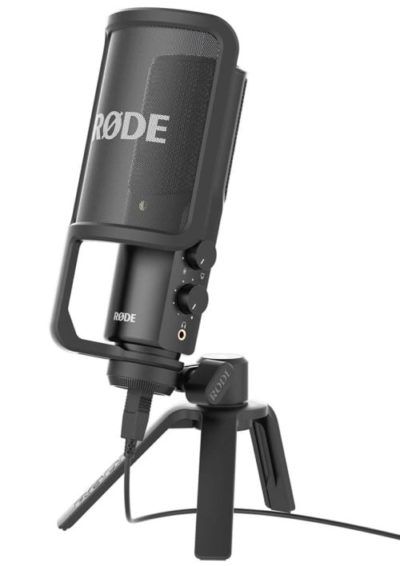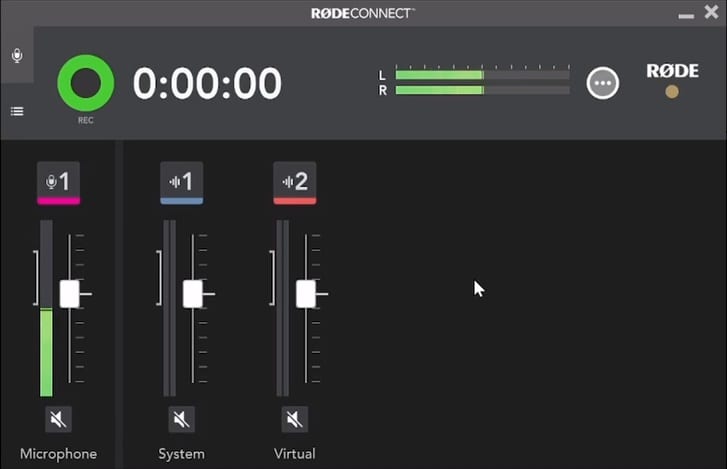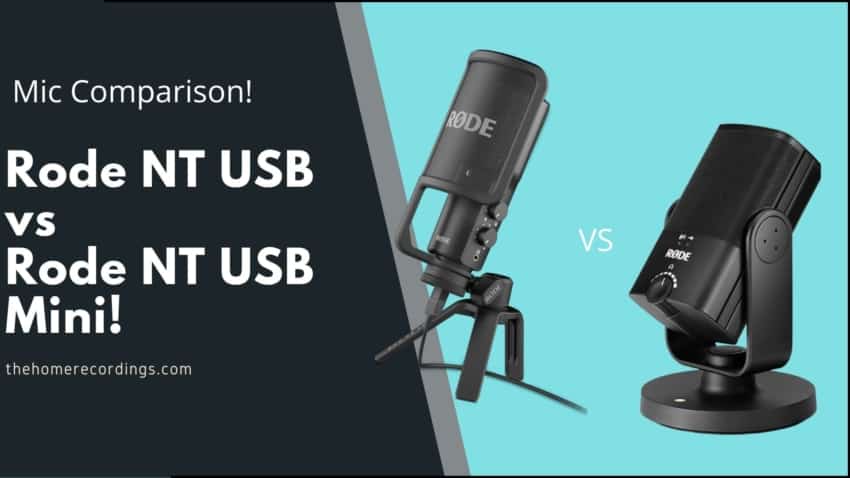Last updated on December 29th, 2023 at 09:53 pm
Rode released the new “Mini” version of their famous NT USB microphone, but is it any good? Is it better than the Rode NT USB itself? What are the differences between the two?
In this article, I will be answering all those questions, their pros and cons, difference in price, included software, and more.
So, without any further ado, let’s get started!
In short, here are the Rode NT USB and Shure MV7 Differences: The Rode NT USB can’t record loud sources because it distorts the sound, even with the gain at zero, whereas the Rode NT USB Mini doesn’t suffer from this issue, plus it comes with the Rode Connect software that lets you process the signal further.
Let’s now jump straight into the post, starting with the Rode mic.
Rode NT USB Overview

Rode is known for making extremely high-quality equipment at reasonable prices, and the Rode NT USB is no exception to this rule (except for one fatal flaw which I will mention in a second).
It comes with a pop filter, which is extremely good, a tripod desk stand which isn’t the best, a ring mount, and a storage pouch.
The two controls on the side are for the headphone volume, which comes in handy when you want to do zero latency monitoring, and the Direct mix control between mic input and source output.
This means that you can choose to hear only what’s coming out of the PC, or to only hear the direct signal from the Mic, or a blend of those two.
Now, you might have noticed that it doesn’t come with a Gain dial, which for a mic in this price-range is just ludicrous. You can control the levels from your PC, however, but this isn’t ideal and I really think that it should have an easier way of controlling it.
This microphone is pretty good for recording singing and spoken word applications, such as podcasting and voice-over, but it’s not that great at recording really loud sources, such as guitar cabinets (I’ll get into more detail when talking about how it performs when recording).
When looking at the build quality I have to say that it’s just great, outstanding in fact: It’s got some weight to it and it doesn’t feel at all flimsy or delicate.
Like I mentioned, it includes a pop filter, which is rare since most microphones don’t include one, and even though it feels a bit cheap, it’s still a free pop filter that works.
Lastly, the Rode NT USB works flawlessly on Windows and Mac OS based computers, as well as the Apple iPad.
What comes in the box?
- The Rode NT USB Microphone
- Pop Filter
- Microphone Stand
- Microphone Mount
- Storage Pouch
Features
- Zero-latency monitoring.
- Comes with a pop filter.
- Extremely good build quality.
How does it sound?
To be honest, I wasn’t as surprised as I thought I would be when trying out this mic, and I did have very high hopes for it since I heard so many great things about it.
For spoken word applications or for quiet singing it works super well: The low ends sound very clear and full, and the mids and highs sound fantastic, very open and airy. However, when recording instruments that are a bit too loud, or any other loud sound source for that matter, even if the signal doesn’t clip, it will sound as if it was clipping.
Also, having no Gain dial makes it a bit of a pain to set the levels correctly…
Other than that, I think that the Rode NT USB does a pretty decent job at doing what it’s supposed to do, just remember to not record very hot signals.
Now, there is one important thing to consider when thinking about getting the Rode NT USB, since it literally costs twice as much in certain European countries than in the US.
I have seen it in the Amazon Store in Germany for almost the same as in the US, but in Spain, and other countries, it usually sells for twice as much.
In this case, you could actually purchase an Audient iD14, which is an insanely good Audio Interface, plus an XLR microphone and have a much better setup for the same money.
What I didn’t like about the Rode NT USB
While live monitoring on the headphones, for some reason it always sounded a bit distorted, even when lowering the gain and the headphone volume output, and I don’t know what that’s about.
However, this didn’t happen when playing back sound from the computer no matter the volume (yes, I nearly blew my eardrums out trying to check this), it only happened while listening to the live signal.
Additionally, lowering the gain to zero and having it still record at a level where you could talk normally and get a respectable signal is not ideal, since louder sources will clip.
And lastly, not having a gain knob, especially on a microphone in this price range, seems like an intentional design flaw.
Specifications
- Polar Pattern; Cardioid
- Frequency Response: 20Hz- 20kHz
- Sample Rate: 48kHz/16-bit
- Max SPL: 110dB
- Weight: 520g
Get the Rode NT USB here.
- Rode NT USB: Amazon, Sweetwater.
Rode NT-USB Mini Overview

The Rode NT USB Mini is the little brother of the Rode NT USB, and it comes with the same feature set but at a much lower price tag. However, I don’t think that it sounds as full, but more on this in a second.
As far as the build quality goes, everything but the grille is excellent, since the grille does flex a little more than the one on the Rode NT USB (the big one), but it’s definitely not enough for me to worry about it getting damaged.
It features one knob on the front that lets you control the headphone volume and that also allows you to enable zero-latency monitoring when tapping on it. A light on top of the knob will turn on indicating that zero-latency monitoring is enabled (the second light only tells you if the mic is connected and getting power).
It comes with a 360-degree swing mount that is excellent for setting up the mic on a boom arm since you can turn it however you want until you get it just right.
Contrary to its bigger brother, the NT USB Mini doesn’t come with an included pop filter, but rather has one already built-in, although I have to say that plosives are still kind of an issue and I would recommend using an external pop filter just in case.
Now, you may have noticed that it only has one knob, which is the one that controls the headphone volume, but where are the gain and Mix knobs? Well, there are none, which is a shame, and you need to control both of these functions from your PC.
I through Rode would’ve learned after not including a gain dial on the NT USB, but they actually went further and removed one more knob.
It’s worth mentioning, however, that even though it would be nice to have dedicated knobs to control the gain and the mix between the computer’s playback and the direct signal, all of this can easily be adjusted through their Rode Connect software.

The Rode Connect software lets you use up to 4 Rode NT USB Minis one a single computer, access some processing which are built into the mic, such as a gate, compression, and more, and it also lets you control the playback volume of different apps and games, which lets you create a nice mix for your stream (great software for gamers).
Lastly, it doesn’t come with a shock mount, and when using it with the included desk stand, it will absolutely pick up all the keyboard strokes, tapping on the desk, or any other types of vibrations that may be present.
What comes in the Box?
- Rode NT USB Mini Microphone
- Desktop Stand
- Microphone Stand adapter
- UNB Cable
Features
- Comes with the Rode Connect Software (Great for streamers & gamers)
- Built-in pop filter.
How does it sound?
The Rode NT USB Mini offers a very balanced sound, especially when recording voice-related stuff and singing: The low end isn’t too prominent or boomy while still being extremely present, the mids are actually quite prominent but I like how this affects the vocals, and the high end is very open and airy without sounding shrill.
So, at least as far as vocals goes, it’s a very balanced sound, and I though the same when recording my acoustic guitar since there was nothing really standing out to me as overly harsh.
The one con I can think of is that, since the mid frequencies are a bit more prominent than in other mics, people who have a very nasally voice might find that that nasally sound will be slightly exaggerated.
Lastly, when recording my electric guitar, it sounded great when recording a clean signal, but I didn’t really like recording distorted guitars with it since it made them sound quite shrill.
However, I didn’t find that it would clip when recording my guitar cabinet like it did with the NT USB.
And lastly, the headphone amp that the Mini comes with is great: It has enough power to drive the Sennheiser HD 650!
Specifications
- Polar Pattern; Cardioid
- Frequency Response: 20Hz- 20kHz
- Sample Rate: 48kHz/24-bit
- Max SPL: 121dB
- Weight: 585g
Get the Rode NT USB MINI here.
- Rode NT USB MINI: Amazon, Sweetwater.
Which one should you go for?
To be honest, I don’t see a reason to go with the standard Rode NT USB since the mini offers all the same benefits at like 70% of the price, plus you can use the Rode Connect app to add processing, mix the volume levels of other apps and games, etc.
So, go with the Rode NT USB Mini (or check out the two alternatives I’m listing below).
Other alternatives
I reviewed a couple USB mics already and there are two that stand out: The Audio-Technica AT2020+ USB and the ElGato Wave 3.
The AT2020+ USB sounds great and offers everything the Rode does at the same price, or lower, but it does feature a gain dial which makes it a better microphone overall.
The Elgato Wave 3 is a relatively new mic that was designed specifically for gamers since it comes with included software designed to help you better control the signal (compression, limiter, etc., and it lets you manage and mix the level of different audio signals, such as music playing, the stream’s volume, mic volume, etc.) similar to the Rode Connect app.
Conclusion
Out of these two microphones, I’d definitely go with the Mini for the simple fact that it’s cheaper, smaller, has a very similar sound quality, and it comes with the Rode Connect software.
The Rode NT USB is still a good microphone to get if you’re doing voice-related work, but it can’t record loud sources without clipping.
So, all in all, go with the Mini.
